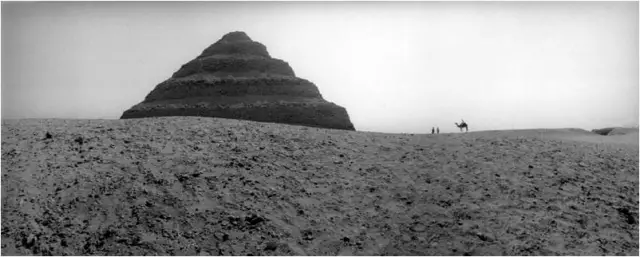
The Pyramid of Djoser, or step pyramid was built for the burial of PHAROH Djoser by his visir IMHOTEP. It was constructed during the 27th century at the Saqqara necropolis to the northwest of the city of Memphis
This first Egyptian pyramid consisted of six masatabas (of decreasing size) built atop one another in what were clearly revisions and developments of the original plan. The pyramid originally stood 62m tall, and having a base of 109m x 125m and was clad in polished white limestone.
HISTORY
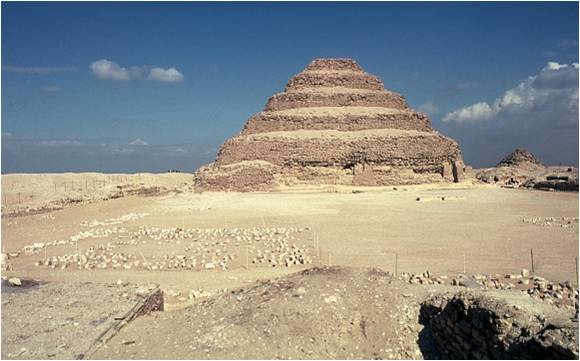
The Great Step Pyramid Complex at Saqqara, known to the ancient Egyptians as kbhw-ntrw (libation of the deities) which is the beginning of an evolutionary period of polished, smooth faced true pyramids in the 3rd Dynasty.
Here limestone was first used on a large scale as a construction material, and here the idea of a monumental royal tomb in the form of a pyramid was first truly realized.
Pyramid of Zoser is the oldest and biggest stone structure of that time. Imhotep (The Architect) found solutions to the problems of moving, precisely placing and securing each of the thousands of blocks.
This discovrey lead to the stone structure buildings.
CONSTRUCTION
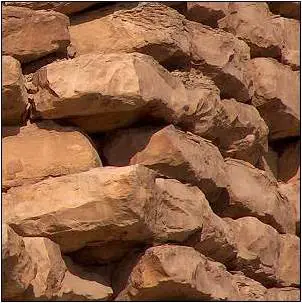
The most common material used for the construction are MUD BRICKS.
The zoser pyramid went through six stages for the structure to eventually reach its final form
The construction started with the square mastaba, usually mastaba’s are in rectangular in shape this was done because they planned to build a step pyramid.
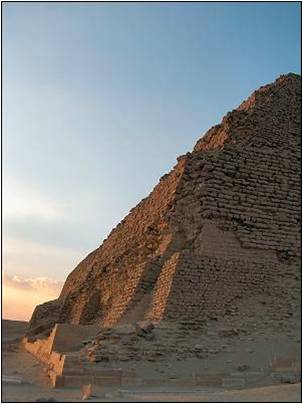
- When the builders started building mastaba, they began by building a crude core of roughly shaped stones with a fine limestone casing and a layer of packing in between. While this technique had been used for mastabas, now there was a profound difference. They abandoned horizontal beds and began to build in accretions that leaned inward. They employed larger and better carved blocks that no longer needed to be packed with large amounts of mortar. Instead, they used clay only as an aid to setting each block on a bed that inclined with the accretion layer.
- Not only was the pyramid itself build in stages, but so too were the surrounding structures. Evidence suggests that the builders partially buried the dummy structures, consisting of the Pavilions of the North and South, the South Tomb and Sed Chapels, almost immediately after they built them during the first stage.
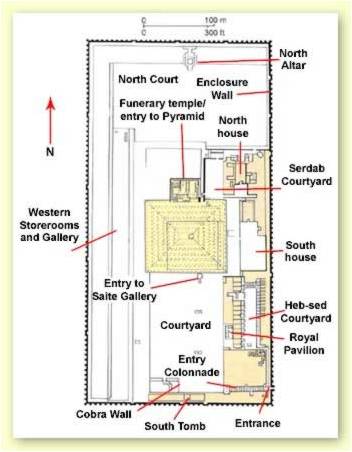
The half-submerging of the dummy buildings signifies the chthonic, underworld aspect of existence after death. And the full envelopment of the mastaba conforms to the pastern of early Egyptian monuments that successive stages conceal earlier ones.
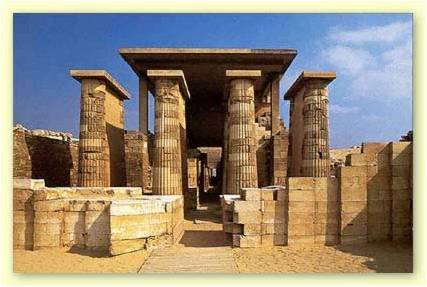
Some researchers distinguished between functional versus fictional structures. With some elements, it was enough that their form or image be present in the facade. Their interior could be abbreviated. They are what have been called dummy buildings. The buildings served the king’s ka in the Afterlife. The functional buildings may have been necessary for the actual conduct of the funerary ceremonies.
Below ground, the Egyptians created an underground structure on a scale previously unknown, quarrying out more than 5.7 kilometers (about 3 1/2 miles) of shafts, tunnels, chambers, galleries and magazines. A central corridor and two parallel ones extend over 365 meters (1,198 feet), connecting 400 rooms. These and other subterranean features surround one of the most complicated tangles of tunnels and shafts the Egyptians ever created, below the pyramid itself.
PYRAMID CONSTRUCTION
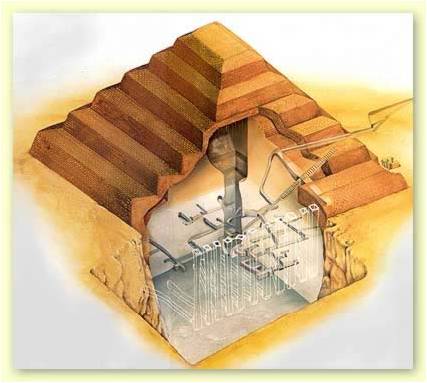
Initially, the structure took the form of a mastaba (stage M1), which was gradually enlarged, first equally on all four sides (stage M2), and then only on the east side (stage M3). However, the step-shaped mastaba was finally rebuilt in two stages, first as a four-step pyramid (stage P1) and finally as a six-step pyramid (stage P2). In its final state it no longer had a square base, but a rectangular one, oriented east-west
In building the pyramid, the masonry was laid not vertically but in courses inclined toward the middle of the pyramid, thus increasing its structural stability. The basic material used was limestone blocks.
Djoser’s tomb were inspired by the form of the rising and setting sun. In fact, from time to time and under specific conditions, an optical illusion is produced that gives the sun’s disk the form of a step pyramid as it rises in the morning or sets in the evening.
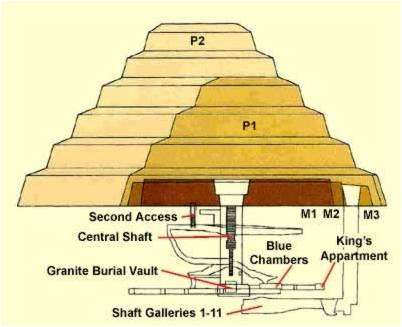
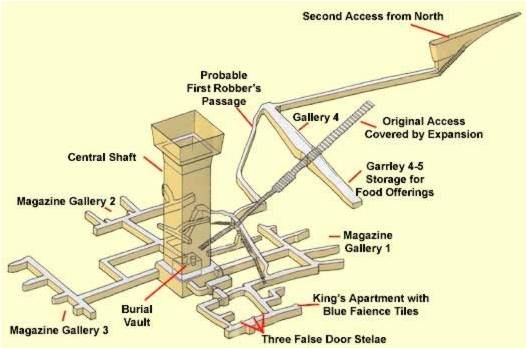
The original entrance for the Step Pyramid’s substructure (upon completion) was a tunnel running along the north-south axis during the first stage (M1). It ran from the floor of the mortuary temple’s western court north of the pyramid. At the beginning of this tunnel was a staircase, and at its end there was a diagonal shaft measuring some 7 meters (23 feet) square.
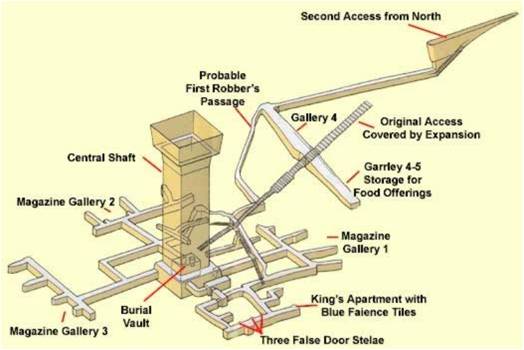
The upper part of this shaft originally sank through the whole superstructure from the roof terrace. Originally, a descending corridor was built joining the shaft from the north, which was probably used to remove waste from the shaft’s construction. However, it was covered over during the expansion of the pyramid in stage P1.
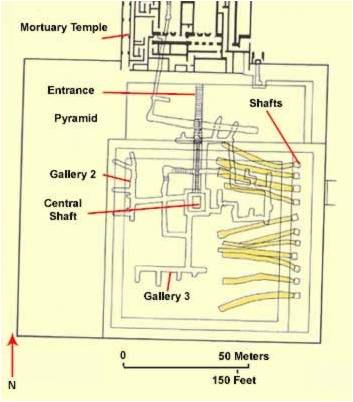
The tomb chamber was located on the floor of the shaft, at a depth of about twenty-eight meters, in the so-called granite chamber. Over the burial chamber’s ceiling was a room called the maneuvering chamber, there the pharaoh’s mummy was prepared for interment. The mummy was then moved down through a round opening in the floor which was afterward closed with a granite block weighing about three tons.

Leave a Reply
You must be logged in to post a comment.